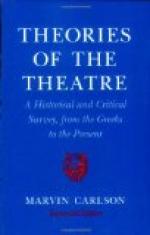But
there is
Divinity about you, that strikes
dead
My rising passions: as
you are my king,
I fall before you, and present
my sword
To cut mine own flesh, if
it be your will.
We may imagine the applause of the courtiers of James Stuart, the Presumptuous; but never since the Cromwellian revolution has that scene been really effective on the English stage. In order fully to appreciate a dramatic struggle, an audience must sympathise with the motives that occasion it.
It should now be evident, as was suggested at the outset, that all the leading principles of the theory of the theatre may be deduced logically from the axiom which was stated in the first sentence of this chapter; and that axiom should constantly be borne in mind as the basis of all our subsequent discussions. But in view of several important points which have already come up for consideration, it may be profitable, before relinquishing our initial question, to redefine a play more fully in the following terms:—
A play is a representation, by actors, on a stage, before an audience, of a struggle between individual human wills, motivated by emotion rather than by intellect, and expressed in terms of objective action.
II
THE PSYCHOLOGY OF THEATRE AUDIENCES
I
The drama is the only art, excepting oratory and certain forms of music, that is designed to appeal to a crowd instead of to an individual. The lyric poet writes for himself, and for such selected persons here and there throughout the world as may be wisely sympathetic enough to understand his musings. The essayist and the novelist write for a reader sitting alone in his library: whether ten such readers or a hundred thousand ultimately read a book, the writer speaks to each of them apart from all the others. It is the same with painting and with sculpture. Though a picture or a statue may be seen by a limitless succession of observers, its appeal is made always to the individual mind. But it is different with a play. Since a drama is, in essence, a story devised to be presented by actors on a stage before an audience, it must necessarily be designed to appeal at once to a multitude of people. We have to be alone in order to appreciate the Venus of Melos or the Sistine Madonna or the Ode to a Nightingale or the Egoist or the Religio Medici; but who could sit alone in a wide theatre and see Cyrano de Bergerac performed? The sympathetic presence of a multitude of people would be as necessary to our appreciation of the play as solitude in all the other cases. And because the drama must be written for a crowd, it must be fashioned differently from the other, and less popular, forms of art.




